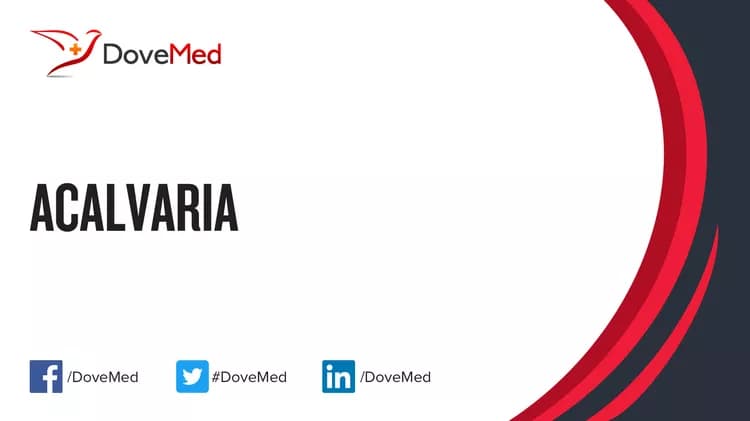What are the other Names for this Condition? (Also known as/Synonyms)
- Primary Acalvaria
What is Acalvaria? (Definition/Background information)
- Acalvaria, also known as Primary Acalvaria, is an extremely rare malformation characterized by the absence of the flat skull bones of the brain, dura mater, and scalp muscles. The skull base and facial features are fully formed and usually appear normal. The cause of Acalvaria is still unknown
- Acalvaria can be distinguished from anencephaly, the most common differential diagnosis, by the presence of a layer of skin overlying the brain matter and normal cerebral hemispheres
- This malformation is most often lethal at birth due to other associated anomalies or to trauma during delivery, but a few surviving infants have been reported
- Prenatal diagnosis via transvaginal ultrasound and/or magnetic resonance imaging is critical for better pregnancy management
- The initial treatment is conservative, mainly aimed at supportive care and management of any associated anomalies, if present
- Infants with Acalvaria are managed conservatively in the newborn period because spontaneous bone growth has been seen in some newborns with other skull abnormalities, such as aplasia cutis congenita
- Skull reconstruction by bone grafting and cranioplasty at school age has been discussed in the literature
(Source: Acalvaria; Genetic and Rare Diseases Information Center (GARD) of National Center for Advancing Translational Sciences (NCATS), USA.)
Who gets Acalvaria? (Age and Sex Distribution)
- Acalvaria is an extremely rare congenital disorder. The presentation of symptoms is seen at birth
- Both males and females may be affected
- Worldwide, individuals of all racial and ethnic groups may be affected
What are the Risk Factors for Acalvaria? (Predisposing Factors)
- Currently, no risk factors have been clearly identified for Acalvaria
It is important to note that having a risk factor does not mean that one will get the condition. A risk factor increases one’s chances of getting a condition compared to an individual without the risk factors. Some risk factors are more important than others.
Also, not having a risk factor does not mean that an individual will not get the condition. It is always important to discuss the effect of risk factors with your healthcare provider.
What are the Causes of Acalvaria? (Etiology)
Presently, the exact cause of development of Acalvaria is not known
What are the Signs and Symptoms of Acalvaria?
The signs and symptoms of Acalvaria may include:
Very frequently present symptoms in 80-99% of the cases: Aplasia/hypoplasia of the cerebellum
Frequently present symptoms in 30-79% of the cases:
- Abnormality of neuronal migration
- Calvarial skull defect
- Postaxial hand polydactyly
Occasionally present symptoms in 5-29% of the cases:
- Abnormal lung lobation
- Abnormality of cardiovascular system morphology
- Holoprosencephaly
- Hydrocephalus
- Hypertelorism
- Omphalocele
- Spina bifida
- Talipes
(Source: Acalvaria; Genetic and Rare Diseases Information Center (GARD) of National Center for Advancing Translational Sciences (NCATS), USA.)
How is Acalvaria Diagnosed?
Acalvaria is diagnosed on the basis of the following information:
- Complete physical examination
- Thorough medical history evaluation
- Assessment of signs and symptoms
- Laboratory tests
- Imaging studies
- Biopsy studies, if necessary
Many clinical conditions may have similar signs and symptoms. Your healthcare provider may perform additional tests to rule out other clinical conditions to arrive at a definitive diagnosis.
What are the possible Complications of Acalvaria?
The complications of Acalvaria may include:
- Severe skull defects
- Abnormal involvement of lungs and heart
Complications may occur with or without treatment, and in some cases, due to treatment also.
How is Acalvaria Treated?
- The initial treatment is conservative, mainly aimed at supportive care and management of any associated anomalies, if present
- Infants with Acalvaria are managed conservatively in the newborn period because spontaneous bone growth has been seen in some newborns with other skull abnormalities, such as aplasia cutis congenita
- Skull reconstruction by bone grafting and cranioplasty at school age has been discussed in the literature
(Source: Acalvaria; Genetic and Rare Diseases Information Center (GARD) of National Center for Advancing Translational Sciences (NCATS), USA.)
How can Acalvaria be Prevented?
- The exact cause and risk factors for Acalvaria are not known at the present time. Therefore, no guidelines or methods are available for the prevention of Acalvaria
What is the Prognosis of Acalvaria? (Outcomes/Resolutions)
- This malformation is most often lethal at birth due to other associated anomalies or to trauma during delivery, but a few surviving infants have been reported
(Source: Acalvaria; Genetic and Rare Diseases Information Center (GARD) of National Center for Advancing Translational Sciences (NCATS), USA.)
Additional and Relevant Useful Information for Acalvaria:
The following DoveMed website link is a useful resource for additional information:
Related Articles
Test Your Knowledge
Asked by users
Related Centers
Related Specialties
Related Physicians
Related Procedures
Related Resources
Join DoveHubs
and connect with fellow professionals


0 Comments
Please log in to post a comment.